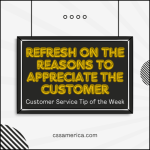It happens all the time in business. The salesperson transitions the new customer to their service representative. The nurse tells the patient about the doctor about to come into the room. The gatekeeper tells the customer about the supervisor they’re about to transfer the customer to, in order to address an issue.
An employee is handing off the customer to a teammate. At this point, the initial employee has a few options. They can (1) Simply conduct the handoff, (2) Make the handoff with a little ambivalent or not-so-positive statement about their co-worker, or (3) Talk up their teammate in the handoff process.
We should strive to set our co-worker up for success. We also want to deliver a great customer experience, one where we’re infusing positivity and building customer confidence.
So, let’s be intentional when we’re making that transition, discussing the co-worker about to enter the conversation, or transferring that call. Let’s be intentional to infuse some positivity and confidence.
Our account holders love working with Jenny! She’s very upbeat, is very responsive to requests or concerns, and she really enjoys getting to know our new customers.
Dr. Smith is excellent. He asks about you, likes to listen and learn, and he’s cared for and helped patients in situations such as yours for over 20 years.
Julio’s definitely the best person to answer your question and help you resolve this issue. I’ll let him know the details of the situation, and I’m sure he’ll ask you questions to confirm things. He’s good at determining the cause of the issue, identifying a solution, and following through on his promise.
Part of delivering a great customer experience requires that we strive to be a great teammate. And when we have to do those handoffs of the customer to a co-worker, be intentional about infusing some positivity and building customer confidence.
Talk Up Your Teammate.
Signup for FREE Tips! Contact Us More Resources for You Visit Our Home Page
























